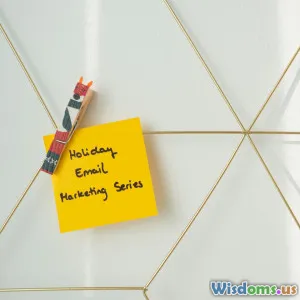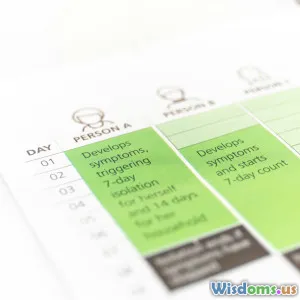
Unlock Higher Opens With These Science Backed Email Subject Line Tactics
10 min read Discover science-based tactics to craft email subject lines that boost open rates and engage your audience more effectively. (0 Reviews)
Unlock Higher Opens With These Science-Backed Email Subject Line Tactics
Introduction
In an era where the average professional receives more than 120 emails daily, cutting through the noise is the holy grail for marketers. Your email’s subject line is the digital doorman; it’s the first impression that determines whether your message will be glanced over or eagerly anticipated. Although the power of subject lines is well-known, many marketers still rely on guesswork or common-sense principles rather than leveraging concrete scientific insights.
What if you could tap into empirical research and cognitive psychology to craft subject lines that consistently unlock higher open rates and captivate your audience? This article dives deep into science-backed tactics—illuminating principles supported by studies, real-world campaigns, and psychological theories—that will empower you to write emails your audience simply can’t ignore.
The Science Behind Email Opens
Before exploring the tactics, it’s crucial to understand why people choose to open or ignore an email. Email engagement is rooted in cognitive psychology and decision-making frameworks:
- Attention Economy: Humans have finite attention. Your subject line must capture it in under 3 seconds to compete with dozens of other messages.
- Curiosity Gap: Psychologist George Loewenstein’s curiosity gap theory explains why partial information in subject lines triggers a desire to learn more.
- Social Proof & Personal Relevance: People are wired to respond to messages that feel personally relevant or validated by their social circles.
A 2023 study by Campaign Monitor analyzed over 1 billion emails and found that even slight tweaks in subject line phrasing impacted open rates by as much as 30%. This underscores the importance of precision and the application of tested strategies.
Tactic #1: Harness Personalization with Psychological Precision
Not Just Names: Behavioral Personalization
Adding the recipient’s name in the subject line can increase open rates by an average of 14.5% (Source: Experian), but personalization goes beyond first names. Behavioral personalization—referencing purchase history, browsing behaviors, or geolocation—delivers stronger engagement.
Example: Instead of “John, check out our sale,” use “John, your favorite running shoes are 20% off today.”
According to the Journal of Marketing Research, personalized subject lines trigger the brain’s reward centers, releasing dopamine and prompting a more positive response toward the email.
Avoid Overuse to Prevent Fatigue
Research indicates repeated, redundant personalization can trigger fatigue or mistrust. Subject lines should blend creativity with personalization to maintain authenticity.
Tactic #2: Utilize Emotionally Charged Words Strategically
Words carry immense power. According to a study by CoSchedule analyzing 300,000 email campaigns, subject lines containing emotional words like "free," "you," "urgent," and "last chance" have higher open rates.
However, an MIT Media Lab experiment found that positive emotional triggers such as "exciting," "exclusive," and "celebrate" generally outperformed fear-driven words when it came to user engagement and brand sentiment.
Example: “Exciting news inside just for you!” outperforms “Don’t miss out or lose your spot.”
Balance is key: Overusing urgency can cause skepticism, but genuine positive emotion invites curiosity and goodwill.
Tactic #3: Leverage Curiosity with the Right Amount of Ambiguity
Curiosity is one of the most powerful levers in marketing. The curiosity gap created by withholding some information motivates people to click.
Dan Pink, author of Drive, notes that curiosity triggers a neural reward pathway, encouraging exploration and learning.
Example: “You won’t believe what just happened…” works if the rest of the email delivers genuine content. Clickbait, however, may increase opens short-term but damages trust over the long haul.
Data from SubjectLine.com reveals that subject lines between 6-10 words with intriguing but clear wording generate the best results. Too vague causes confusion; too explicit leads to boredom.
Tactic #4: Optimize Length and Format Based on Devices and Preferences
Length Matters
The optimal length for a subject line is between 40-50 characters, which fits well on mobile devices—accounting for 61.9% of all email opens worldwide (Litmus, 2023).
Emails with shorter subject lines can increase open rates by up to 12%, especially if they contain power words and personalization.
Use of Symbols and Emojis
According to Mailchimp’s 2023 report, subject lines featuring emojis saw a 56% higher open rate when appropriate to the audience and context. However, the key word is "appropriate"—a financial newsletter benefits less from heavy emoji use than a lifestyle brand.
Example: “🎉 Your VIP Access Starts Now!” can add excitement.
Avoid Spam Triggers
Science-backed filters show that excessive punctuation (!!??) or capitalization can trigger spam flags, reducing deliverability. Testing tools like MailTester or SpamAssassin can help ensure your subject lines clear these filters.
Tactic #5: Send at the Right Time, Using Behavioral Data
When you send directly influences whether an email is opened. Research by HubSpot demonstrates that emails sent between 8 AM and 10 AM on Tuesdays and Thursdays have the highest open rates.
Going deeper, segmenting your audience by time zone and analyzing past engagement patterns allows for hyper-optimized timing.
Example: An e-commerce brand noticing that a segment of their users engages more in the evening can schedule follow-up emails accordingly to reap higher open rates.
Automation tools using AI can predict best send times, tailoring subject lines and schedules per recipient behavior, both proven to increase engagement by up to 20%.
Tactic #6: Test Consistently and Evolve Subject Lines with A/B Testing
Data without action is wasted. Robust marketers run iterative A/B tests on subject lines to discover what resonates with specific audiences.
For instance, Litmus found a SaaS company increased open rates by 25% after testing different word choices that better matched their audience’s tone and value proposition. The winner combined personalization, a sense of urgency, and curiosity in just 7 words.
Tips for A/B Testing:
- Test one variable at a time (e.g., length, emotional words, or emoji use).
- Use statistically significant samples.
- Track open rates consistently over sample periods.
Regular testing forestalls complacency and keeps your campaigns fresh, responsive, and relevant.
Conclusion
Crafting email subject lines that unlock higher open rates is both an art and a science. With over-traveled inboxes and ever-shortening attention spans, relying solely on gut feeling or outdated maxims no longer suffices. Science-backed tactics—such as precise personalization, invoking the right emotions, employing curiosity smartly, optimizing length and format, timing sends effectively, and maintaining rigorous A/B testing—can dramatically elevate your email's impact.
By understanding and embracing these evidence-based strategies, marketers can foster stronger connections with their audiences, increase engagement metrics, and ultimately drive meaningful business outcomes. The next time you draft that subject line, ask yourself: Does it from the heart, backed by science—and ready to be clicked?
Unlock your email's true potential with these proven approaches and watch your open rates soar.
References:
- Campaign Monitor, 2023: Email Marketing Benchmarks
- Experian, 2022: Personalization Impact Study
- CoSchedule, 2023: Emotional Impact on Email Campaigns
- MIT Media Lab, 2022: Emotional Response and User Engagement
- Litmus Email Analytics Report, 2023
- HubSpot, 2023: Best Time to Send Email
- SubjectLine.com Analytics, 2023
- Journal of Marketing Research: Neural Reward and Personalization, 2021
Rate the Post
User Reviews
Popular Posts



















